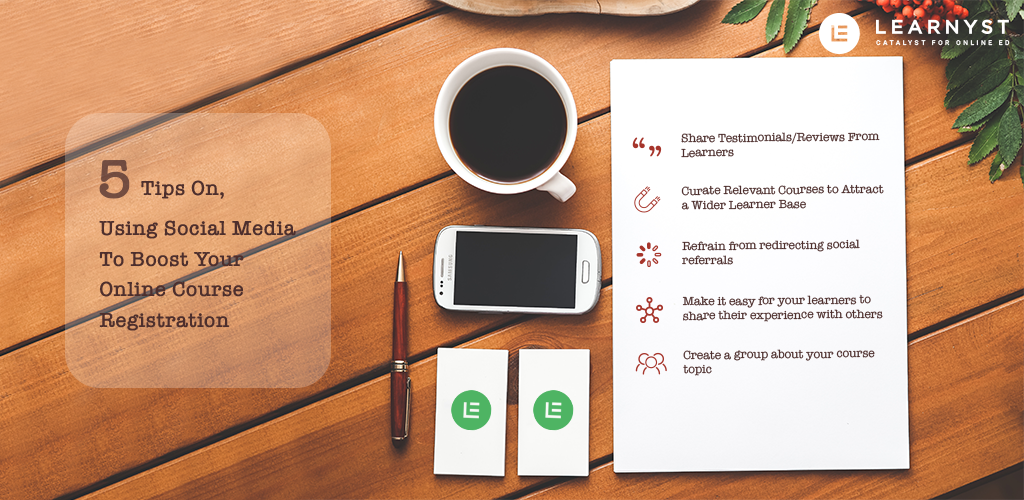5 Tips On Using Social Media To Boost Your Online Course Registration
- April 18 2018
- Ranjan
With the advent of the internet, it has been the go-to tool for the up and coming entrepreneurs to put their businesses out in the public to get more traffic and sign-ups on their business website. And your online teaching institution is no different than this. Running an online teaching website with little to no student is as disheartening as running a school in the polar regions. But with proper marketing strategy, you can reach out to your potential learners and convert them to your learners and generate more revenue. And the new age is social media marketing, using social media to boost your online course registration is the next big move that you can make.
Here in this article, we have noted down 5 acid tested routes to follow on social media to boost the learner sign up on your online teaching platform.
5 Tips On Using Social Media To Boost
1. Share Testimonials/Reviews From Learners
As an online educator, you should collect testimonials from your learners as soon as they complete the course or mock tests and as often as possible. Testimonials are seen as social proofs, which are incredibly useful in the marketing process of your courses to other potential learners.
In addition to including student testimonials on the landing page on your online institution, start sharing those testimonials on social media. Whenever a testimonial is shared on social media, it creates curiosity among the potential learners and makes them click a link to your online teaching website. Once they land on your website, seeing additional testimonials from other learners will serve as additional proof of the value someone gets when they sign up for your course.
2. Curate Relevant Courses to Attract a Wider Learner Base
Social media is a great place to share free content that helps your target audience. But unless you’re creating a lot of free content (mini-lessons, mini-tests, video lessons, podcasts, etc) at a regular interval, you might not have a lot of content to share.
What you can do instead is share content that other people are creating (with their permission, because you don’t want to get in copyright infringement). By sharing content that is relevant to your own course content or course topic on social media, you are more likely to attract learners that are potential subscribers to your course.
This happens a lot on Twitter, where users are recommended accounts to follow, based on their interests and who they’re currently following. Once you have found the right content, schedule it with #tags and @mentions for maximum exposure. This will help you build your audience that you can direct to your website to learn more about your courses.
3. Refrain from redirecting social referrals
People have short attention spans and limited patience. In fact, 60% of online learners abandon websites that take longer than 3 seconds to load. Redirects are a stalling and slow technique that people generally hate to go through.
By redirecting your potential learners to a third-party website, you lose control over your own branding and the ability to capture the leads. When creating social media posts, make sure you’re directing visitors to the page that you’ve described in your posts. Make the journey as short and ungated as possible and remove the unnecessary hurdles for your learners.
4. Make it easy for your learners to share their experience with others
A lot of e-commerce companies have started to prompt their customers to tweet or share about their recent purchase on social media. These include the use of auto-generated tweets, or small checkboxes on the subscription form to prompt people to share.
You can use the same idea in your online course marketing. Make it easy for your website visitors and course learners to share their experience on social media. You could even encourage your existing learners to share their progress or celebrate specific milestones, like certificates on social media as they complete your courses.
Not only will this help you to create a valid social proof for your course, it will also increase your exposure to other potential learners that are connected to your existing learners on social media.
5. Create a group about your course topic
Creating a private group on social media is a great way to build a community around your area of expertise. This gives your target a place to connect with each other, talk about your course topic, and in many cases, talk about your courses for you!
So for now you can try out these routes on social media and see your learner base growing exponentially. And you can expand your reach to more learners through the right use of social media. Please let us know how Using Social Media To Boost Your Online Course Registration helped you in getting more learners just add a comment below. Have we missed out on any point here? Please let us know on hello@learnyst.com.


Leave your thought here